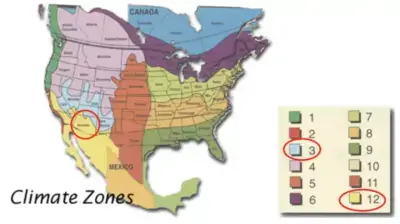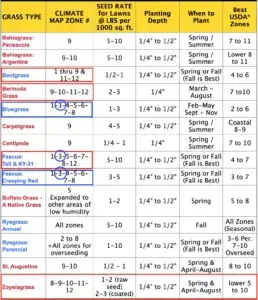In Arizona, grass seeds face a particular challenge.
The varying elevations and extreme climates within the state demand that grass seeds be more resistant to extreme conditions. Harsh sunlight in dry drought-like conditions is just as hard on warm-season grasses as they would be on misplanted cool-season grasses.
Even the state’s favorites like bermudagrass can’t always live up to the split between Arizona’s barren deserts and high-altitude. That’s why the development of drought-resistant and even cold-tolerant varieties of bermudagrass is so important in a state like Arizona.
If you’re planning to revitalize your lawn, and you’d like it to survive and thrive from one season to the next, you may need to overseed, plan your planting cycle, and pay particular attention to your city’s elevation.
What are the Most Common Arizona Grass Seeds?
As it turns out, you can grow grass in the desert — but you’ll need to know which grass seed types are right for the land you’re using.
Now, Arizona is not in a transition zone like so many other parts of the country, so you don’t need to worry about using transition-zone-only varieties of grass seeds. You may also not need to use a mixture of warm-season and cool-season grass.
Most of the state comes under climate zone 12, which is “Warm/Arid.” There is also a smaller region in the northeastern part of the state that falls under the “Cool/Arid” zone.
So while your grass can be either warm or cool-season, depending on which climate zone you fall in, you want to make sure that the variety is hearty enough to withstand “arid” conditions in Arizona.
Seed application cycles matter when you’re planting grass seeds in Arizona. You will need to plant each type following the other if you plan to have a lush lawn each year.
So, once your warm-season grass is ready to begin its dormant period, you’ll need to plant a cool-season grass seed that does well in colder temperatures.
If you live in a desert region of the state, plan to begin planting earlier in the spring and later in the fall. Homeowners at high-elevation cities like Flagstaff, Prescott, Payson, and Showlow should plant fall grass seed as early as August.
Cool-Season Grass Types for Northern Regions
Cool-season grass seeds in Arizona work best in elevations at 4,500 feet and above. Areas lower than this elevation that also do well with cool-season grasses include Kingman, Globe, Safford, and high elevation areas in Cochise County, Verde Valley area, and Window Rock.
These areas do well with 4-6 months of bermudagrass followed by:
- Annual ryegrass
- Perennial ryegrass
In the fall, you can plant any of these grass seeds in preparation for growing during the winter months in Arizona. Perennial ryegrass, for example, will die out during warm months, which is when your bermudagrass “wakes up” again and takes over your lawn. Any cool-season grasses should be planted in mid-September to late October (for desert areas), and in August for high-elevation cities.
Pro-Tip: If you’re using ryegrass seed to overseed, plant during mid-October to mid-November. Plant too early and the heat from the sun’s rays will destroy the seedlings. However, if you plant too close to the edge of oncoming cold winter weather, your ryegrass seed may not even germinate. Don’t be fooled by a “mild” autumn. Make it a rule not to plant seeds after Thanksgiving.
Warm-Season Grass Types for Southern and Low Desert Regions
Warm-season grasses work well in low altitudes and the desert regions of Arizona. These fall along zone 12 of the climate chart, or, “Warm/Arid,” but again your choice of when to plant will depend on the elevation of your city.
In general, late spring and early summer is the best time to plant warm-season grasses, which include:
- Bermudagrass
- Zoysiagrass
- Buffalograss
- Bahiagrass
Many homeowners choose to kill off their perennial ryegrass completely before planting warm-season grasses. To do this, trim your grass less than an inch in height before re-seeding with bermuda grass or any other variety. Each grass seed type has its ideal planting months.
For bermuda grass planted at desert elevation, it’s best if you plant after May 15th. Those at a higher elevation can wait until June 1st but shouldn’t seed after July. Zoysiagrass, on the other hand, works best when planted from April to August but, ideally, no later than the end of July.
Since summer temperatures can rise into the triple digits in Arizona, timing, rather than seed mixture or varieties, is everything when you’re planting for a successful lawn.
The Best Grass Seeds for Arizona
There are a few varieties of grass seed types that have made their way into the Arizona lawn and continue to be highly popular, year after year. From their soft, lush feel to their hearty, foot-traffic-friendly natures, these five grass seeds seem to crop up on homeowners’ lawns frequently.
1) Bermudagrass
Low-maintenance and high-quality lawns are the results of bermudagrass. It has a very dense structure, leading to a lush, soft lawn. Plus, its beautiful blue-green color makes it picture-perfect.
It’s also one of the most versatile grass seed types, with minimal fertilization needs, and you can use either a reel or rotary lawnmower. Despite this, it’s a very robust grass that holds up well to kid- and pet-traffic.
2) Perennial Ryegrass
Perennial rye grass is also a popular choice, but it’s usually used for overseeding warm-season grasses. It has shiny, smooth leaves with a medium-coarse texture and is much more attractive than annual ryegrass. If you’re seeding this in a colder region, make sure to mix it with Kentucky bluegrass for best results.
3) St. Augustine
St. Augustine works best if you have buildings casting long shadows on your property or many tall trees providing shade. It’s a grass seed type that is unique for its ability to thrive in the shade — even for the majority of the day. With as little as four hours of direct sunlight a day, St. Augustine thrives and maintains its thick, green appearance.
It remains this way long into the fall, before going dormant for a brief spell during the winter, and emerging again in the spring. It’s also hearty — it takes quite a few heavy frosts before St. Augustine goes dormant. However, these features come with a trade-off: St. Augustine doesn’t do well with overseeding, so you may need to make your peace with a brown lawn all winter.
Find The Best Seeds For Your Area With Nature’s Seed
Elevation and desert climates in Arizona pose the greatest challenge to individuals who want to ensure a thriving lawn all year long. Even a hearty grass type like bermudagrass can face challenges because its roots can go to a depth of five or six feet, and it needs at least a few showers to help it establish. The rigor and establishment of your lawn are bound to be tested by Arizona’s arid climate, so it’s important to choose premium-quality lawn blends.
At Nature Seed, we offer you only the highest quality turfgrass varieties, top-rated by the National Turfgrass Evaluation Program. Regardless of the climate or your lawn’s previous situation, we have the right blend to help you grow your own way.
Learn more about our Seed Selector tool for Arizona or browse our curated collection of grass seed types today.


